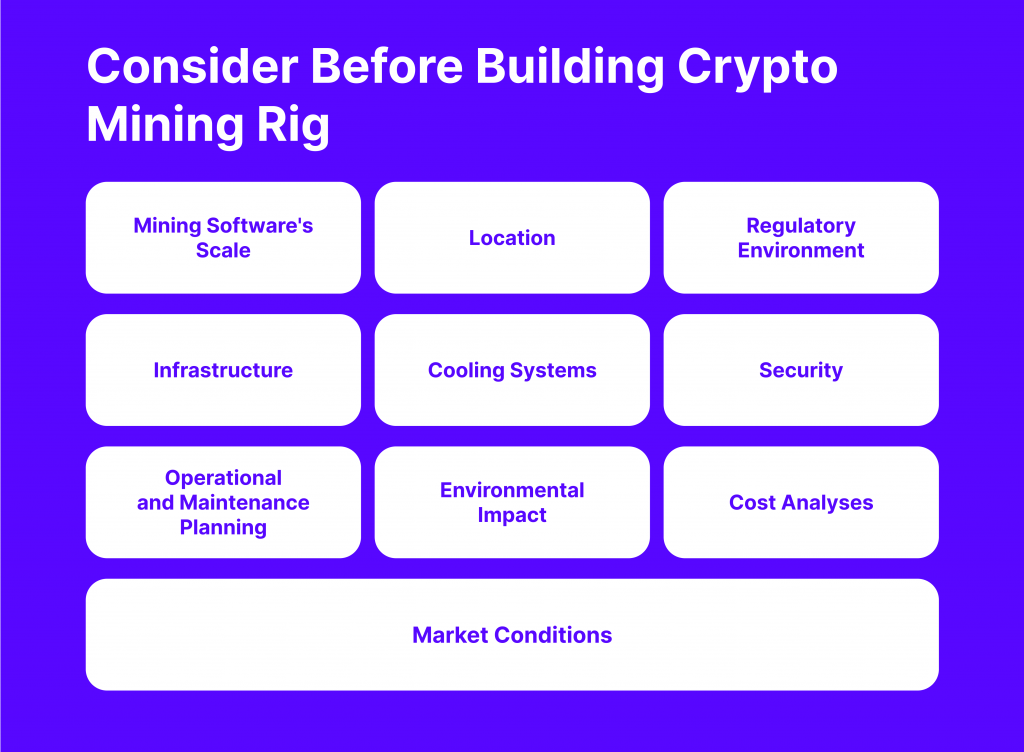Crypto Mining Rigs Explained: Presenting the World of Cryptocurrency Mining
An integral element of blockchain networks, crypto mining, has witnessed a fascinating evolution with the advent of various mining rigs. From the humble CPU mining days to the dominance of ASIC miners, each type of rig brings unique features and challenges to the table.
In this extensive survey, we will delve into the intricacies of crypto mining rigs, unravelling their types, functionalities, and the critical factors that come into play when selecting or building a crypto mining rig.
Key Takeaways:
- Cryptocurrency mining involves using computer hardware to secure blockchain networks, contributing to network security and earning miners financial incentives.
- Higher hash rates increase the chances of successfully mining a block, impacting profitability.
- Mining setups, or rigs, vary from CPUs to GPUs, ASICs, FPGAs, and cloud mining services.
Understanding Crypto Mining Basics

Crypto mining involves using computer hardware to execute the computational processes that secure a blockchain network. Not only does this contribute to the network’s security by preventing attacks, but it also financially incentivises miners through block rewards, typically in the native coin of the network.
These mining setups, often colloquially referred to as rigs, encompass various forms, including CPUs, GPUs, ASICs, FPGAs, and cloud mining services.
How to Build a Mining Rig

Setting up your own mining rig, whether it’s for cryptocurrencies like Bitcoin or other resources, involves various considerations to ensure efficiency, profitability, and environmental sustainability. Here are vital considerations in mining software:
Hash rate
The hash rate refers to the speed at which a mining rig or network can perform cryptographic hash functions essential for validating transactions and creating new blocks in a blockchain. The hash rate is typically measured in hashes per second (H/s). Still, larger units like kilohashes (KH/s), megahashes (MH/s), gigahashes (GH/s), terahashes (TH/s), and even petahashes (PH/s) are commonly used, depending on the scale of the mining software.
As more miners participate in a network, the overall hash rate increases. Blockchain networks are designed to adjust their mining difficulty periodically to ensure that blocks are mined relatively constantly, maintaining a consistent block time. Higher hash rates increase the probability of successfully mining a block and earning the associated rewards.
Miners with more hash power have a better chance of being the first to solve the cryptographic puzzle required to add a new block to the blockchain.
Location: Climate and Electricity Costs
Consider the climate of the area. Mining hardware generates heat so that cooler climates may reduce the need for extensive cooling systems. Choose a location with affordable electricity rates, as the power supply unit is a significant expense for mining.
Regulatory Environment
Ensure compliance with local and national regulations regarding mining activities, environmental standards, and energy consumption. Obtain all necessary permits and licenses for using crypto mining rigs.
Infrastructure
Assess the availability and reliability of the power infrastructure in the chosen location. Reliable and high-speed internet connectivity is crucial for communication and data transfer in mining cryptocurrencies.
Mining Hardware
Choose the specialised hardware based on the type of resource being mined. Consider the scalability of the mining operation, allowing for future expansion if necessary.
Cooling Systems
Implement effective cooling systems to dissipate the heat generated by crypto-mining hardware. This is crucial for maintaining equipment efficiency and longevity.
Security
Secure the mining facility against theft, vandalism, or unauthorised access. Protect the mining pool against cyber threats and hacking attempts to safeguard sensitive data and digital assets.
Operational and Maintenance Planning
Implement monitoring systems to track the performance of mining hardware and detect potential issues. Develop regular maintenance protocols to ensure the longevity and efficiency of mining equipment.
Environmental Impact
Consider the environmental impact of mining pools and adopt sustainable practices. Develop plans for responsible waste disposal and environmental reclamation, if applicable.
Cost Analysis
Conduct a Total Cost Analysis (TCO), including initial investment, operational costs, and expected returns. Assess the profitability of the mining industry based on current market conditions and projections.
Market Conditions
Stay informed about market trends, as they can impact the profitability and viability of mining operations.
Fast Fact
On Jan. 3, 2009, pseudonymous creator Satoshi Nakamoto mined the first Bitcoin block. As the only crypto miner on the Bitcoin network, Nakamoto didn’t need specialised equipment to launch the blockchain.
Types of Crypto Mining Rigs

Crypto mining rigs come in various types, each designed for specific purposes and preferences. The choice of a mining rig depends on factors such as the type of cryptocurrency being mined, mining algorithm, budget, and scalability. Here are some common types of crypto mining rigs.
CPU Mining Rig
Initially, crypto mining was performed using Central Processing Units (CPUs). It uses everyday hardware found in laptops and desktop computers. However, with the advent of more advanced mining algorithms, CPU mining has become less efficient and is generally not practical for many cryptocurrencies.
Some cryptos, including Bytecoin, Zcash, and Monero, that use CPU-friendly algorithms may still be mined using general-purpose CPUs, fostering decentralisation.
GPU Mining Rig Takes Center Stage
Graphics Processing Units (GPUs) became the standard for mining due to their parallel processing capabilities, making them well-suited for certain mining algorithms like Ethereum’s Ethash. GPU hash rates, measured in megahashes per second (mh/s), increased substantially, making them a popular choice.
GPUs are the best crypto mining rigs for many, especially memory-intensive ones or use algorithms that can be efficiently parallelised. Its parallel processing capability and flexibility to mine multiple coins positioned it as the go-to solution, particularly for Ethereum and other altcoins.
Dominant ASIC Mining Rigs
Application-specific integrated Circuit (ASIC) miners revolutionised the crypto-mining landscape, particularly for Bitcoin. Released in 2012, the first ASIC miner surpassed GPU miners’ power by around 200 times. ASIC mining power is measured in terahashes per second (th/s), with top models as of 2021 reaching 90-100 th/s. Despite their dominance, ASIC miners come with a hefty price tag, ranging from $2,000 to $15,000, making them a significant investment that requires careful consideration.
ASICs are common Bitcoin mining rigs, while altcoins are usually mined with SHA-256 or other ASIC-friendly algorithms.
FPGA Miners: Balancing Power and Flexibility
Field-Programmable Gate Array (FPGA) miners represent a middle ground, offering enhanced speed and efficiency compared to GPUs. They can be reprogrammed for different algorithms, providing flexibility compared to ASICs. What sets FPGAs apart is their ability to reconfigure themselves to mine a variety of coins, giving flexibility similar to GPUs but with greater hashing power.
However, the FPGA mining rig demands higher technical expertise for setup and configuration. They are less common than GPUs and ASICs but are sometimes used by crypto miners who seek a balance between customisation and efficiency.
Cloud Mining: Rig-Free Crypto Mining Experience
Cloud mining presents an alternative approach, allowing individuals to mine cryptocurrencies indirectly by renting hash power supply units from cloud mining providers. This approach minimises upfront costs and maintenance requirements, making it an attractive option for those entering the mining space.
Cloud mining suits individuals needing more technical expertise, space, or resources to set up and maintain their own mining rigs. However, caution is advised, as selecting a reputable mining provider is crucial to avoiding potential scams.
Hybrid Mining Rigs
Hybrid mining rigs combine different types of hardware, such as ASICs and GPUs, to balance efficiency and flexibility. This allows Bitcoin miners to adapt to algorithm changes or switch between cryptocurrencies.
Miners who want versatility and the ability to switch between mining different cryptocurrencies may opt for hybrid setups.
Mobile Mining
Some mobile applications claim to allow users to mine crypto using the processing power of their mobile devices. However, the legitimacy and effectiveness of such apps are often questionable.
Mobile mining is generally not recommended due to the limited processing power of mobile devices and concerns about battery life and device integrity.
When choosing a mining rig, it’s essential to consider factors such as the specific cryptocurrency you intend to mine, the algorithm it uses, upfront costs, ongoing operational expenses (especially electricity costs), and the potential for future upgrades or changes in mining algorithms. Additionally, staying informed about the latest mining hardware and software developments is crucial for making informed decisions.
Conclusion
Despite the rise of Proof-of-Stake networks that eliminate the mining process, traditional Proof-of-Work blockchains like Bitcoin maintain their allure. Whether one chooses to mine cryptocurrency, directly purchase digital assets, or adopt a combination strategy depends on individual factors such as investment philosophy, risk tolerance, and technical knowledge.
As technology advances, the evolution of mining rigs will undoubtedly play a pivotal role in shaping the future of decentralised finance and blockchain technology.



